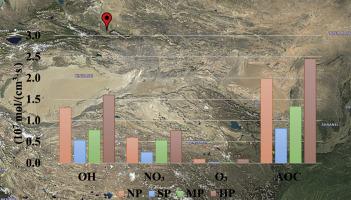乌鲁木齐冬季PM2.5雾霾期间大气氧化能力及其对二次污染的影响
IF 6.3
2区 环境科学与生态学
Q1 ENVIRONMENTAL SCIENCES
引用次数: 0
摘要
大气氧化能力(AOC)是指大气化学过程对主要污染物的氧化能力。对乌鲁木齐市2024年1月15日至2月15日的一次典型PM2.5污染事件进行了综合观测。采用0-D大气模型框架(Framework for 0-D Atmospheric Modeling)估算PM2.5中AOC、OH反应性、它们与二次分量的关系以及HOx收支。芳烃和烷烃分别贡献了54% - 79%和18% - 46%的次生有机气溶胶(SOA)形成。硫氧化比(SOR)和氮氧化比(NOR)随PM2.5浓度的升高而升高。随着AOC的增加,SOR呈现相同的趋势,而NOR和SOA略有下降,氨氧化比值基本保持不变。OH自由基是白天的主要氧化剂,而NO3在夜间起主导作用。CO(24% - 51%)、NO2(27% -34%)和烯烃(7% - 12%)是OH反应性的主要贡献者。HO2 + NO反应途径对OH生成的贡献为67% - 84%,而其他(包括羰基化合物光解、RO2的排列反应等)、RO2 + NO和OH + CO反应途径是产生HO2的主要途径。全面了解AOC、SOA和自由基循环之间的相互作用对于制定有效的空气质量管理策略以减轻不同大气条件下的二次污染至关重要。本文章由计算机程序翻译,如有差异,请以英文原文为准。

Atmospheric oxidation capacity and its influence on secondary pollution during winter PM2.5 haze episodes in Urumqi
Atmospheric oxidation capacity (AOC) refers to the oxidation capacity of atmospheric chemical processes for major pollutants. A comprehensive observation campaign was conducted on a typical PM2.5 pollution event in Urumqi, Northwest China, from January 15 to February 15, 2024. Four typical cases representing PM2.5 levels from non-polluted to heavily polluted periods were selected to estimate AOC, OH reactivity, their relationship with secondary components, and the HOx budget in PM2.5 using the Framework for 0-D Atmospheric Modeling model. Aromatics and alkanes contributed 54 %-79 % and 18 %-46 % of secondary organic aerosols (SOA) formation, respectively. The sulfur oxidation ratio (SOR) and nitrogen oxidation ratio (NOR) increased with rising PM2.5 levels. As AOC increased, SOR showed the same trend, while NOR and SOA decreased slightly, and ammonia oxidation ratio values remained almost unchanged. OH radicals were the primary oxidants during the daytime, whereas NO3 played a dominant role at nighttime. CO (24 %-51 %), NO2 (27 %-34%), and alkenes (7 %-12 %) were the dominant contributors to OH reactivity. The HO2 + NO reaction pathway contributes 67 %-84 % to the production of OH, while Others (including carbonyl compounds photolysis, the permutation reactions of RO2, etc.), RO2 + NO and OH + CO reaction pathways were the main pathways for HO2 production. A comprehensive understanding of the interactions among AOC, SOA, and radical cycling is crucial for formulating effective air quality management strategies aimed at mitigating secondary pollution under diverse atmospheric conditions.
求助全文
通过发布文献求助,成功后即可免费获取论文全文。
去求助
来源期刊

Journal of Environmental Sciences-china
环境科学-环境科学
CiteScore
13.70
自引率
0.00%
发文量
6354
审稿时长
2.6 months
期刊介绍:
The Journal of Environmental Sciences is an international journal started in 1989. The journal is devoted to publish original, peer-reviewed research papers on main aspects of environmental sciences, such as environmental chemistry, environmental biology, ecology, geosciences and environmental physics. Appropriate subjects include basic and applied research on atmospheric, terrestrial and aquatic environments, pollution control and abatement technology, conservation of natural resources, environmental health and toxicology. Announcements of international environmental science meetings and other recent information are also included.
 求助内容:
求助内容: 应助结果提醒方式:
应助结果提醒方式:


